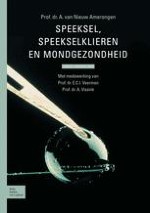2008 | OriginalPaper | Hoofdstuk
12 Speeksel en spijsvertering
Auteur : Prof. dr. A. van Nieuw Amerongen
Gepubliceerd in: Speeksel, speekselklieren en mondgezondheid
Uitgeverij: Bohn Stafleu van Loghum
Samenvatting
-
Speeksel speelt een belangrijke rol bij de vertering van voedsel. Door de doordrenking van hard voedsel met speeksel, gecombineerd met het kauwproces, worden de voedselbestanddelen beter toegankelijk voor de spijsverteringsenzymen en worden deze gemakkelijker gesplitst in het spijsverteringskanaal.
-
De enzymatische afbraak van voedingseiwitten onder invloed van proteolytische enzymen in speeksel is waarschijnlijk zeer beperkt.
-
Linguaal lipase speelt een belangrijke rol bij de enzymatische hydrolyse van neutrale lipiden, omdat dit enzym nog geruime tijd kan doorwerken in de maag. Binnen dertig minuten wordt 10-15% van de neutrale lipiden gehydrolyseerd onder invloed van dit speekselenzym.
-
Parotis-DNase-1 is in staat om, bij neutrale pH, DNA vanuit voeding in kleinere fragmenten te knippen.
-
De grootste bijdrage levert speeksel aan de vertering van de polysachariden zetmeel en glycogeen. Door de grote hoeveelheid amylase in speeksel – in PAR-speeksel vormt het zelfs 30% van al het eiwit – en doordat het niet gemakkelijk wordt gedenatureerd, kan speekselamylase een belangrijk deel van het zetmeel en glycogeen vanuit het dieet splitsen tot oligosachariden. Deze worden in de dunne darm vervolgens onder invloed van pancreasamylase, maltase en α(1-6)-glucosidase gesplitst tot glucose-eenheden, die uiteindelijk worden geresorbeerd.
-
Opvallend is dat verschillende primaire longtumoren relatief grote hoeveelheden amylase van het speekseltype synthetiseren en afgeven aan de bloedbaan. Dit resulteert in een drastische stijging van de amylase-activiteit in serum.
-
Er is een relatie tussen chronische buikpijnklachten en het optreden van alfa-amylase in grote complexen met immuunglobulinen. De achterliggende oorzaak hiervan is onbekend. Mogelijk gaat het hier om een auto-immuunziekte.
-
Bij stofwisselingsafwijkingen leidend tot sialoadenose, bijvoorbeeld als gevolg van anorexia nervosa, boulimia nervosa, alcoholisme en een slecht gereguleerde diabetes mellitus, neemt de amylaseconcentratie in speeksel toe.
-
Αmylase kan zich selectief hechten aan een aantal micro-organismen. Bij Neisseria spp. en Legionella spp. resulteert dit in groeiremming. Αmylasebinding aan S. gordonii lijkt de bacterie in staat te stellen polysachariden zoals zetmeel te gebruiken als bron voor glucose.
